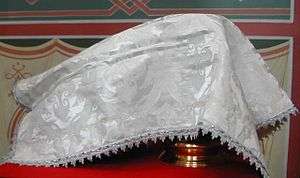
Aër
The Aër (Greek: Ἀήρ, lit. the "air"; modern Greek: Αέρας; Slavonic: Воздýхъ, Vozdúkh) is the largest and outermost of the veils covering the Chalice and Diskos (paten) in the Eastern Orthodox Church and the Eastern Catholic Churches which follow the Byzantine Rite. It is rectangular in shape and corresponds to the veil used to cover the chalice and paten in the Latin Rite, but is larger. It is often made of the same material and color as the vestments of the officiating priest, and often has a fringe going all the way around its edge. Tassels may also be sewn at each of the corners.
It takes its name either from the lightness of the material of which it is made, or from the fact that during the Nicene Creed in the Divine Liturgy, the priest holds it high in the air and waves it slowly over the Chalice and Diskos. Its original use was to cover the Chalice and prevent anything from falling into it before the consecration. It symbolizes the swaddling clothes with which Christ was wrapped at his Nativity, and also the grave clothes in which he was wrapped at his burial (both themes are found in the text of the Liturgy of Preparation).

Ağrı
Ağrı, formerly known as Karaköse (Kurdish: Qerekose) from the early Turkish republican period until 1946, and before that as Karakilisa (also rendered as Karakilise) (Ottoman: قرهکلیسا), is the capital of Ağrı Province at the eastern end of Turkey, near the border with Iran.
History
In the Ottoman Empire era the area was called Şorbulak. The current town centre was founded around 1860 by a group of Armenian merchants from Bitlis with the name Karakilise ("the black church") that became known to the local population as Karakise and this version was turned officially to Karaköse at the beginning of the Republican era. This name was changed to Ağrı by 1946.
In the medieval period, the district's administrative centre was located at Alashkert, once an important town. The "kara kilise" that gave the town its name was a medieval Armenian church. In 1895 Lynch stayed in Karakilise and wrote that it had between 1500-2000 inhabitants, was nearly two-thirds Armenian, and that a barracks for a locally-recruited Kurdish Hamidiyeh regiment had been recently located in the town.
Çağrı
Çağrı is a unisex Turkish given name. In Turkish, "Çağrı" means "The Call", "Appellation", and/or "Distinction". It also means "Falcon". Notable people with the name include:
Given name
Surname
He (disambiguation)
He is the third-person singular masculine nominative case pronoun in Modern English.
It may also refer to:
Language
Alphabets
Other
Literature
Film and music
People
Legendary
Honorifics
7 Horns 7 Eyes
7 Horns 7 Eyes is an American Christian progressive death metal band based out of Seattle, Washington. The band formed in 2006 and released their debut album Throes of Absolution on April 24, 2012, on Century Media Records in North America and Basick Records in Europe. On January 10, 2014, after being silent for nearly two years, Vocalist JJ Polachek announced the band is working on three potential releases for 2014 and 2015. It was described as large a conceptual work.
History
Formation and 7 Horns 7 Eyes
In 2006, friends, Kyle Wood, Brandon and Aaron Smith, Chris Weiford, and Steven Bye started a band, that they named 7 Horns 7 Eyes, which comes from Revelation 5:6 in the Bible. They recorded their self titled debut EP in 2006 and released it in 2007. After 7 Horns 7 Eyes was released, Weiford and Bye left the band and were replaced by friend Sean Alf, and Ryan Wood, Kyle's brother.
"Huntour", Convalescence EP, and Throes of Absolution
In 2009, the band was selected for Demon Hunter's first annual "Huntour" along with the resurrected Living Sacrifice, The Famine, Focused, and Advent. After the "Huntour" the band began to record their first album and released the first single of the album, "The Vindicator". After recording the whole album, Kyle Wood left to get married. Aaron Smith then contacted his friend JJ "Shiv" Polachek of Monotheist, to be the new vocalist and re-record vocals. In 2011, the band released Convalescence EP and in 2012, their debut album, Throes of Absolution was released. After the release, Sean Alf left the band, and was replaced by Zack Uidl.

H&E stain
Hematoxylin and eosin stain or haematoxylin and eosin stain (H&E stain or HE stain) is one of the principal stains in histology. It is the most widely used stain in medical diagnosis and is often the gold standard; for example when a pathologist looks at a biopsy of a suspected cancer, the histological section is likely to be stained with H&E and termed "H&E section", "H+E section", or "HE section". A combination of hematoxylin and eosin, it produces blues, violets, and reds.
Principle
The staining method involves application of hemalum, a complex formed from aluminium ions and hematein (an oxidation product of hematoxylin). Hemalum colors nuclei of cells (and a few other objects, such as keratohyalin granules and calcified material) blue. The nuclear staining is followed by counterstaining with an aqueous or alcoholic solution of eosin Y, which colors eosinophilic structures in various shades of red, pink and orange.
The staining of nuclei by hemalum is ordinarily due to binding of the dye-metal complex to DNA, but nuclear staining can be obtained after extraction of DNA from tissue sections. The mechanism is different from that of nuclear staining by basic (cationic) dyes such as thionine or toluidine blue. Staining by basic dyes occurs only from solutions that are less acidic than hemalum, and it is prevented by prior chemical or enzymatic extraction of nucleic acids. There is evidence to indicate that coordinate bonds, similar to those that hold aluminium and hematein together, bind the hemalum complex to DNA and to carboxy groups of proteins in the nuclear chromatin.
Podcasts:

